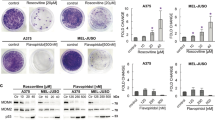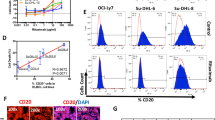Abstract
Mcl-1 is an antiapoptotic Bcl-2 family member, whose degradation is supposedly required for the induction of apoptosis. However, histone deacetylase inhibitors (HDACi) induce apoptosis primarily through the Bak/Mcl-1/Noxa and Bim pathways without decreasing Mcl-1. To investigate this discrepancy, we examined the role of Mcl-1 on HDACi-mediated apoptosis. Inhibition of either class I or class II HDAC by selective HDACi caused an upregulation of Mcl-1 mRNA and protein. Downregulation of Mcl-1 by three structurally unrelated cyclin-dependent kinase inhibitors potentiated HDACi-mediated apoptosis in primary chronic lymphocytic leukemic (CLL) cells and K562 cells. Sensitivity to HDACi-induced apoptosis was increased ∼10-fold by the cyclin-dependent kinase inhibitors. Nanomolar concentrations of HDACi, ∼300-fold lower than that required to induce apoptosis alone, sensitized cells to TRAIL, emphasizing that the mechanism(s) whereby HDACi induce apoptosis is clearly distinct from those by which they sensitize to TRAIL. Furthermore, knockdown of Mcl-1-potentiated HDACi-mediated apoptosis in K562 cells. Thus, HDACi-mediated Mcl-1 upregulation plays an important antiapoptotic regulatory role in limiting the efficacy of HDACi-induced apoptosis, which can be overcome by combination with an agent that downregulates Mcl-1. Thus, a clinical trial in some cancers is warranted using a combination of an HDACi with agents that downregulate Mcl-1.
This is a preview of subscription content, access via your institution
Access options
Subscribe to this journal
Receive 12 print issues and online access
$259.00 per year
only $21.58 per issue
Buy this article
- Purchase on Springer Link
- Instant access to full article PDF
Prices may be subject to local taxes which are calculated during checkout




Similar content being viewed by others
References
Danial NN, Korsmeyer SJ . Cell death: critical control points. Cell 2004; 116: 205–219.
Adams JM, Cory S . The Bcl-2 apoptotic switch in cancer development and therapy. Oncogene 2007; 26: 1324–1337.
Huang DC, Strasser A . BH3-only proteins-essential initiators of apoptotic cell death. Cell 2000; 103: 839–842.
Labi V, Erlacher M, Kiessling S, Villunger A . BH3-only proteins in cell death initiation, malignant disease and anticancer therapy. Cell Death Differ 2006; 13: 1325–1338.
Kitada S, Andersen J, Akar S, Zapata JM, Takayama S, Krajewski S et al. Expression of apoptosis-regulating proteins in chronic lymphocytic leukemia: correlations with in vitro and in vivo chemoresponses. Blood 1998; 91: 3379–3389.
Pedersen IM, Kitada S, Leoni LM, Zapata JM, Karras JG, Tsukada N et al. Protection of CLL B cells by a follicular dendritic cell line is dependent on induction of Mcl-1. Blood 2002; 100: 1795–1801.
Petlickovski A, Laurenti L, Li X, Marietti S, Chiusolo P, Sica S et al. Sustained signaling through the B-cell receptor induces Mcl-1 and promotes survival of chronic lymphocytic leukemia B cells. Blood 2005; 105: 4820–4827.
Craig RW . MCL1 provides a window on the role of the BCL2 family in cell proliferation, differentiation and tumorigenesis. Leukemia 2002; 16: 444–454.
Michels J, Johnson PW, Packham G . Mcl-1. Int J Biochem Cell Biol 2005; 37: 267–271.
Opferman JT, Iwasaki H, Ong CC, Suh H, Mizuno S, Akashi K et al. Obligate role of anti-apoptotic MCL-1 in the survival of hematopoietic stem cells. Science 2005; 307: 1101–1104.
Fritsch RM, Schneider G, Saur D, Scheibel M, Schmid RM . Translational repression of MCL-1 couples stress-induced eIF2 alpha phosphorylation to mitochondrial apoptosis initiation. J Biol Chem 2007; 282: 22551–22562.
Rosato RR, Almenara JA, Kolla SS, Maggio SC, Coe S, Gimenez MS et al. Mechanism and functional role of XIAP and Mcl-1 down-regulation in flavopiridol/vorinostat antileukemic interactions. Mol Cancer Ther 2007; 6: 692–702.
Wang JM, Chao JR, Chen W, Kuo ML, Yen JJ, Yang-Yen HF . The antiapoptotic gene mcl-1 is up-regulated by the phosphatidylinositol 3-kinase/Akt signaling pathway through a transcription factor complex containing CREB. Mol Cell Biol 1999; 19: 6195–6206.
Inoshita S, Takeda K, Hatai T, Terada Y, Sano M, Hata J et al. Phosphorylation and inactivation of myeloid cell leukemia 1 by JNK in response to oxidative stress. J Biol Chem 2002; 277: 43730–43734.
Maurer U, Charvet C, Wagman AS, Dejardin E, Green DR . Glycogen synthase kinase-3 regulates mitochondrial outer membrane permeabilization and apoptosis by destabilization of MCL-1. Mol Cell 2006; 21: 749–760.
Mandelin II AM, Pope RM . Myeloid cell leukemia-1 as a therapeutic target. Expert Opin Ther Targets 2007; 11: 363–373.
Nijhawan D, Fang M, Traer E, Zhong Q, Gao W, Du F et al. Elimination of Mcl-1 is required for the initiation of apoptosis following ultraviolet irradiation. Genes Dev 2003; 17: 1475–1486.
Snowden RT, Sun XM, Dyer MJ, Cohen GM . Bisindolylmaleimide IX is a potent inducer of apoptosis in chronic lymphocytic leukaemic cells and activates cleavage of Mcl-1. Leukemia 2003; 17: 1981–1989.
Adams KW, Cooper GM . Rapid turnover of mcl-1 couples translation to cell survival and apoptosis. J Biol Chem 2007; 282: 6192–6200.
Cuconati A, Mukherjee C, Perez D, White E . DNA damage response and MCL-1 destruction initiate apoptosis in adenovirus-infected cells. Genes Dev 2003; 17: 2922–2932.
Willis SN, Chen L, Dewson G, Wei A, Naik E, Fletcher JI et al. Proapoptotic Bak is sequestered by Mcl-1 and Bcl-xL, but not Bcl-2, until displaced by BH3-only proteins. Genes Dev 2005; 19: 1294–1305.
Marks PA, Richon VM, Miller T, Kelly WK . Histone deacetylase inhibitors. Adv Cancer Res 2004; 91: 137–168.
Rosato RR, Grant S . Histone deacetylase inhibitors: insights into mechanisms of lethality. Expert Opin Ther Targets 2005; 9: 809–824.
Zhang Y, Adachi M, Kawamura R, Imai K . Bmf is a possible mediator in histone deacetylase inhibitors FK228 and CBHA-induced apoptosis. Cell Death Differ 2006; 13: 129–140.
Zhao Y, Tan J, Zhuang L, Jiang X, Liu ET, Yu Q . Inhibitors of histone deacetylases target the Rb-E2F1 pathway for apoptosis induction through activation of proapoptotic protein Bim. Proc Natl Acad Sci USA 2005; 102: 16090–16095.
Inoue S, Riley J, Gant TW, Dyer MJ, Cohen GM . Apoptosis induced by histone deacetylase inhibitors in leukemic cells is mediated by Bim and Noxa. Leukemia 2007; 21: 1773–1782.
Inoue S, MacFarlane M, Harper N, Wheat LM, Dyer MJ, Cohen GM . Histone deacetylase inhibitors potentiate TNF-related apoptosis-inducing ligand (TRAIL)-induced apoptosis in lymphoid malignancies. Cell Death Differ 2004; 11: S193–S206.
Inoue S, Mai A, Dyer MJ, Cohen GM . Inhibition of histone deacetylase class I but not class II is critical for the sensitization of leukemic cells to tumor necrosis factor-related apoptosis-inducing ligand-induced apoptosis. Cancer Res 2006; 66: 6785–6792.
Brown GR, Bamford AM, Bowyer J, James DS, Rankine N, Tang E et al. Naphthyl ketones: a new class of Janus kinase 3 inhibitors. Bioorg Med Chem Lett 2000; 10: 575–579.
Coll-Mulet L, Iglesias-Serret D, Santidrian AF, Cosialls AM, de Frias M, Castano E et al. MDM2 antagonists activate p53 and synergize with genotoxic drugs in B-cell chronic lymphocytic leukemia cells. Blood 2006; 107: 4109–4114.
Michels J, O'Neill JW, Dallman CL, Mouzakiti A, Habens F, Brimmell M et al. Mcl-1 is required for Akata6 B-lymphoma cell survival and is converted to a cell death molecule by efficient caspase-mediated cleavage. Oncogene 2004; 23: 4818–4827.
Qian DZ, Kato Y, Shabbeer S, Wei Y, Verheul HM, Salumbides B et al. Targeting tumor angiogenesis with histone deacetylase inhibitors: the hydroxamic acid derivative LBH589. Clin Cancer Res 2006; 12: 634–642.
Kawaguchi Y, Kovacs JJ, McLaurin A, Vance JM, Ito A, Yao TP . The deacetylase HDAC6 regulates aggresome formation and cell viability in response to misfolded protein stress. Cell 2003; 115: 727–738.
Chen R, Keating MJ, Gandhi V, Plunkett W . Transcription inhibition by flavopiridol: mechanism of chronic lymphocytic leukemia cell death. Blood 2005; 106: 2513–2519.
Kitada S, Zapata JM, Andreeff M, Reed JC . Protein kinase inhibitors flavopiridol and 7-hydroxy-staurosporine down-regulate antiapoptosis proteins in B-cell chronic lymphocytic leukemia. Blood 2000; 96: 393–397.
Strasser A, Puthalakath H . Fold up or perish: unfolded protein response and chemotherapy. Cell Death Differ 2008; 15: 223–225.
Czabotar PE, Lee EF, van Delft MF, Day CL, Smith BJ, Huang DC et al. Structural insights into the degradation of Mcl-1 induced by BH3 domains. Proc Natl Acad Sci USA 2007; 104: 6217–6222.
Zhong Q, Gao W, Du F, Wang X . Mule/ARF-BP1, a BH3-only E3 ubiquitin ligase, catalyzes the polyubiquitination of Mcl-1 and regulates apoptosis. Cell 2005; 121: 1085–1095.
Dai Y, Grant S . Targeting multiple arms of the apoptotic regulatory machinery. Cancer Res 2007; 67: 2908–2911.
van Delft MF, Wei AH, Mason KD, Vandenberg CJ, Chen L, Czabotar PE et al. The BH3 mimetic ABT-737 targets selective Bcl-2 proteins and efficiently induces apoptosis via Bak/Bax if Mcl-1 is neutralized. Cancer Cell 2006; 10: 389–399.
Shapiro GI . Cyclin-dependent kinase pathways as targets for cancer treatment. J Clin Oncol 2006; 24: 1770–1783.
Han J, Goldstein LA, Gastman BR, Rabinowich H . Interrelated roles for Mcl-1 and BIM in regulation of TRAIL-mediated mitochondrial apoptosis. J Biol Chem 2006; 281: 10153–10163.
Ricci MS, Kim SH, Ogi K, Plastaras JP, Ling J, Wang W et al. Reduction of TRAIL-induced Mcl-1 and cIAP2 by c-Myc or sorafenib sensitizes resistant human cancer cells to TRAIL-induced death. Cancer Cell 2007; 12: 66–80.
Taniai M, Grambihler A, Higuchi H, Werneburg N, Bronk SF, Farrugia DJ et al. Mcl-1 mediates tumor necrosis factor-related apoptosis-inducing ligand resistance in human cholangiocarcinoma cells. Cancer Res 2004; 64: 3517–3524.
Acknowledgements
We thank Ms Joan Riley and Dr Shu Dong Zhang for validation of the primers for the real-time reverse transcription-PCR and statistical analysis, respectively. We thank Mr Roger Snowden for sharing data. This work was supported primarily by the UK Medical Research Council and some support from the Leukemia Research Fund.
Author information
Authors and Affiliations
Corresponding author
Additional information
Supplementary Information accompanies the paper on the Leukemia website (http://www.nature.com/leu)
Rights and permissions
About this article
Cite this article
Inoue, S., Walewska, R., Dyer, M. et al. Downregulation of Mcl-1 potentiates HDACi-mediated apoptosis in leukemic cells. Leukemia 22, 819–825 (2008). https://doi.org/10.1038/leu.2008.1
Received:
Revised:
Accepted:
Published:
Issue Date:
DOI: https://doi.org/10.1038/leu.2008.1
Keywords
This article is cited by
-
Chidamide and venetoclax synergistically exert cytotoxicity on multiple myeloma by upregulating BIM expression
Clinical Epigenetics (2022)
-
Histone Deacetylase Inhibitor SAHA Induces Expression of Fatty Acid-Binding Protein 4 and Inhibits Replication of Human Cytomegalovirus
Virologica Sinica (2021)
-
Novel HDAC inhibitor MAKV-8 and imatinib synergistically kill chronic myeloid leukemia cells via inhibition of BCR-ABL/MYC-signaling: effect on imatinib resistance and stem cells
Clinical Epigenetics (2020)
-
Characterization of TET and IDH gene expression in chronic lymphocytic leukemia: comparison with normal B cells and prognostic significance
Clinical Epigenetics (2016)
-
Design of novel BH3 mimetics for the treatment of chronic lymphocytic leukemia
Leukemia (2012)



